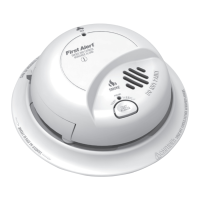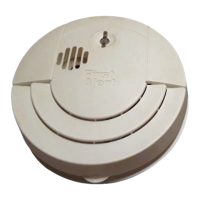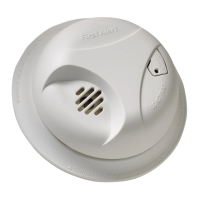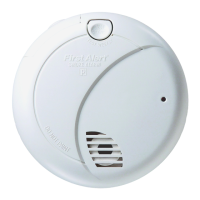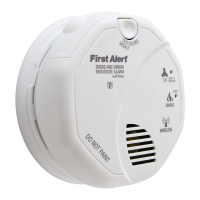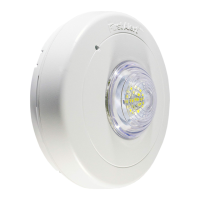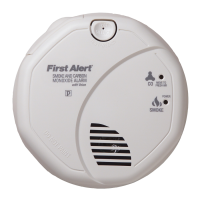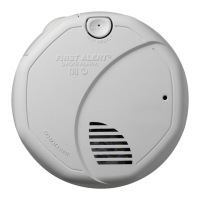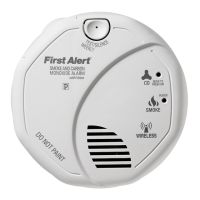! WARNING!
The Silence Feature does not disable the unit—it makes it temporarily less sensitive to smoke. For your safety, if
smoke around the unit is dense enough to suggest a potentially dangerous situation, the unit will stay in Alarm
or may re-Alarm quickly. If you do not know the source of the smoke, do not assume it is an unwanted Alarm. Not
responding to an Alarm can result in property loss, injury, or death.
SILENCING THE LOW BATTERY WARNING
This Silence Feature can temporarily quiet the Low Battery Warning “chirp”. Press the Test/Silence button on the Alarm.
The Red light ashes normally, once every 6 minutes, during Low Battery Warning silence. After time, the low battery
“chirp” will resume. Deactivate the Smoke Alarm and replace it immediately.
IF YOU SUSPECT A PROBLEM
Smoke Alarms may not operate properly because of a dead or weak battery, a build-up of dirt, dust or grease on
the Smoke Alarm cover, or installation in an improper location. Clean the Smoke Alarm as described in “Regular
Maintenance,” and then test the Smoke Alarm again. If it fails to test properly when you use the test button, or if the
problem persists, replace the Smoke Alarm immediately.
• If you hear 3 or 5 chirps every minute or so, replace the Smoke Alarm.
• If you experience frequent non-emergency Alarms (like those caused by cooking smoke), try relocating
the Smoke Alarm.
• If the Alarm sounds when no smoke is visible, try cleaning or relocating the Smoke Alarm. The cover may be dirty.
• If the Alarm does not sound during testing, make sure the power pack activating lever is pushed all the way securely.
Do not try xing the Alarm yourself — this will void your warranty!
If the Smoke Alarm is still not operating properly, and it is still under warranty, please see “How to Obtain Warranty
Service” in the Limited Warranty.
08
REGULATORY INFORMATION FOR SMOKE ALARMS
RECOMMENDED LOCATIONS FOR SMOKE ALARMS
INSTALLING SMOKE ALARMS IN SINGLE-FAMILY RESIDENCES
The National Fire Protection Association (NFPA), recommends one Smoke Alarm on every level, in every sleeping area,
and in every bedroom. In new construction, the Smoke Alarms must be AC powered and interconnected. See “Agency
Placement Recommendations” for details. For additional coverage, it is recommended that you install a Smoke Alarm in
all rooms, halls, storage areas, nished attics, and basements, where temperatures normally remain between 40˚ F (4.4˚
C) and 100˚ F (37.8˚ C). Make sure no door or other obstruction could keep smoke from reaching the Smoke Alarms.
MORE SPECIFICALLY, INSTALL SMOKE ALARMS:
• On every level of your home, including nished attics and basements.
• Inside every bedroom, especially if people sleep with doors closed.
• In the hall near every sleeping area. If your home has multiple sleeping areas, install a unit in each.
• If a hall is over 40 feet (12 meters) long, install an Alarm at each end.
• At the top of the rst-to-second level stairway, and at bottom of basement stairway.
IMPORTANT!
Specic requirements for Smoke Alarm installation vary from state to state and from region to region. Check with your
local Fire Department for current requirements in your area. It is recommended AC or AC/DC units be interconnected
for added protection.
09
AGENCY PLACEMENT RECOMMENDATIONS
NFPA 72 CHAPTER 29 “FOR YOUR INFORMATION, THE NATIONAL FIRE ALARM AND SIGNALING CODE, NFPA 72,
READS AS FOLLOWS:”
29.5.1* Required Detection.
29.5.1.1* Where required by other governing laws, codes, or standards for a specic type of occupancy, approved single
and multiple-station Smoke Alarms shall be installed as follows:
1. *In all sleeping rooms and guest rooms
2. *Outside of each separate dwelling unit sleeping area, within 21 ft (6.4 m) of any door to a sleeping room, with the
distance measured along a path of travel
3. On every level of a dwelling unit, including basements
4. On every level of a residential board and care occupancy (small facility), including basements and excluding crawl
spaces and unnished attics
5. *In the living area(s) of a guest suite
6. In the living area(s) of a residential board and care occupancy (small facility)
(Reprinted with permission from NFPA 72
®
, National Fire Alarm and Signaling Code Copyright © 2012 National Fire
Protection Association, Quincy, MA 02269. This reprinted material is not the complete and ofcial position of the National
Fire Protection Association, on the referenced subject which is represented only by the standard in its entirety).
(National Fire Alarm and Signaling Code
®
and NFPA 72
®
are registered trademarks of the National Fire Protection
Association, Inc., Quincy, MA 02269).
CALIFORNIA STATE FIRE MARSHAL (CSFM)
Early warning detection is best achieved by the installation of re detection equipment in all rooms and areas of the
household as follows: A Smoke Alarm installed in each separate sleeping area (in the vicinity, but outside bedrooms), and
Heat or Smoke Alarms in the living rooms, dining rooms, bedrooms, kitchens, hallways, nished attics, furnace rooms,
closets, utility and storage rooms, basements, and attached garages.
10
SPECIAL COMPLIANCE CONSIDERATIONS
This Smoke Alarm is suitable for use in apartments, condominiums, townhouses, hospitals, day care facilities, health care
facilities, boarding houses, group homes and dormitories provided a primary re detection system already exists to meet
re detection requirements in common areas like lobbies, hallways, or porches. Using this Smoke Alarm in common areas
may not provide sufcient warning to all residents or meet local re protection ordinances/regulations.
This Smoke Alarm alone is not a suitable substitute for complete re detection systems in places housing many
people—like apartment buildings, condominiums, hotels, motels, dormitories, hospitals, health care facilities, nursing
homes, day care facilities, or group homes of any kind. It is not a suitable substitute for complete re detection systems
in warehouses, industrial facilities, commercial buildings, and special-purpose non-residential buildings which require
special re detection and Alarm systems. Depending on the building codes in your area, this Smoke Alarm may be used to
provide additional protection in these facilities.
In new construction, most building codes require the use of AC or AC/DC powered Smoke Alarms only. In existing
construction, AC, AC/DC, or DC powered Smoke Alarms can be used as specied by local building codes. THIS
EQUIPMENT SHOULD BE INSTALLED IN ACCORDANCE WITH THE NATIONAL FIRE PROTECTION ASSOCIATION’S STANDARD
72 (National Fire Protection Association, Batterymarch Park, Quincy, MA 02269). Refer to NFPA 101 (Life Safety Code),
local building codes, or consult your Fire Department for detailed re protection requirements in buildings not dened
as “households”.
11
GENERAL LIMITATIONS OF SMOKE ALARMS
Smoke Alarms have played a key role in reducing deaths resulting from home res worldwide. However, like any warning
device, Smoke Alarms can only work if they are properly located, installed, and maintained, and if smoke reaches them.
They are not foolproof.
Smoke Alarms may not waken all individuals. Practice the escape plan at least twice a year, making sure that
everyone is involved – from kids to grandparents. Allow children to master re escape planning and practice before
holding a re drill at night when they are sleeping. If children or others do not readily waken to the sound of the Smoke
Alarm, or if there are infants or family members with mobility limitations, make sure that someone is assigned to assist
them in re drill and in the event of an emergency. It is recommended that you hold a re drill while family members are
sleeping in order to determine their response to the sound of the Smoke Alarm while sleeping and to determine whether
they may need assistance in the event of an emergency.
Smoke Alarms cannot work without power. Battery operated units cannot work if the batteries are missing,
disconnected or dead, if the wrong type of batteries are used, or if the batteries are not installed correctly. AC units cannot
work if the AC power is cut off for any reason (open fuse or circuit breaker, failure along a power line or at a power
station, electrical re that burns the electrical wires, etc.). If you are concerned about the limitations of battery or AC
power, install both types of units.
Smoke Alarms cannot detect res if the smoke does not reach the Alarms. Smoke from res in chimneys or walls,
on roofs, or on the other side of closed doors may not reach the sensing chamber and set off the Alarm. That is why one
unit should be installed inside each bedroom or sleeping area—especially if bedroom or sleeping area doors are closed
at night—and in the hallway between them.
Smoke Alarms may not detect re on another level or area of the home. For example, a stand-alone unit on the
second level may not detect smoke from a basement re until the re spreads. This may not give you enough time to
escape safely. That is why recommended minimum protection is at least one unit in every sleeping area, and every
bedroom on every level of your home. Even with a unit on every level, stand-alone units may not provide as much
protection as interconnected units, especially if the re starts in a remote area. Some safety experts recommend installing
interconnected AC powered units with battery back-up (see “About Smoke Alarms”) or professional re detection
systems, so if one unit senses smoke, all units Alarm. Interconnected units may provide earlier warning than stand-alone
units since all units Alarm when one detects smoke.
Smoke Alarms may not be heard. Though the Alarm horn in this unit meets or exceeds current standards, it may not be
heard if: 1) the unit is located outside a closed or partially closed door, 2) residents recently consumed alcohol or drugs,
3) the Alarm is drowned out by noise from stereo, TV, trafc, air conditioner or other appliances, 4) residents are hearing
impaired or sound sleepers. Special purpose units, like those with visual and audible Alarms, should be installed for
hearing impaired residents.
The Alarm may not have time to Alarm before the re itself causes damage, injury, or death, since smoke from
some res may not reach the unit immediately. Examples of this include persons smoking in bed, children
playing with matches, when a person’s clothing catches re while cooking, res caused by violent explosions
resulting from escaping gas, or incendiary res where the re grows so rapidly that an occupant’s egress is
blocked even with properly located Smoke Alarms.
Smoke Alarms are not foolproof. Like any electronic device, Smoke Alarms are made of components that can wear out
or fail at any time. You must test the unit weekly to ensure your continued protection. Smoke Alarms cannot prevent or
extinguish res. They are not a substitute for property or life insurance.
Smoke Alarms have a limited life. The unit should be replaced immediately if it is not operating properly. You should
always replace a Smoke Alarm after 10 years from date of purchase. Write the purchase date on the space provided
on back of unit.
12
LIMITED WARRANTY
First Alert
®
warrants that for a period of ten years from the date of purchase, this product will be free from defects in
material and workmanship. First Alert, at its option, will repair or replace this product or any component of the product
found to be defective during the warranty period. Replacement will be made with a new or remanufactured product or
component. If the product is no longer available, replacement may be made with a similar product of equal or greater
value. This is your exclusive warranty.
This warranty is valid for the original retail purchaser from the date of initial retail purchase and is not transferable.
Keep the original sales receipt. Proof of purchase is required to obtain warranty performance. First Alert dealers, service
centers, or retail stores selling First Alert products do not have the right to alter, modify or any way change the terms and
conditions of this warranty.
This warranty does not cover normal wear of parts or damage resulting from any of the following: negligent use or
misuse of the product, use on improper voltage or current, use contrary to the operating instructions, disassembly, repair
or alteration by anyone other than First Alert or an authorized service center. Further, the warranty does not cover Acts of
God, such as re, ood, hurricanes and tornadoes.
First Alert shall not be liable for any incidental or consequential damages caused by the breach of any express or implied
warranty. Except to the extent prohibited by applicable law, any implied warranty of merchantability or tness for a
particular purpose is limited in duration to the duration of the above warranty. Some states, provinces or jurisdictions
do not allow the exclusion or limitation of incidental or consequential damages or limitations on how long an implied
warranty lasts, so the above limitations or exclusion may not apply to you. This warranty gives you specic legal rights,
and you may also have other rights that vary from state to state or province to province.
HOW TO OBTAIN WARRANTY SERVICE
Service: If service is required, do not return the product to your retailer. In order to obtain warranty service, contact the
Consumer Support Team at 1-800-323-9005. To assist us in serving you, please have the model number and date of
purchase available when calling.
Disposal: Please follow local guidelines regarding the disposal or recycling of batteries and/or electronics.
The Alarm should be deactivated before disposal. See, “To Permanently Deactivate the Smoke Alarm”.
For your records, please record:
Date Purchased: ___________________________
Where Purchased: __________________________
Date Installed: __________/__________Month/Year
Replace Alarm 10 years after installation.
Please write the date in the space provided:
_____________/____________Month/Year
The Alarm will also provide
an audible End-of-Life Signal
approximately 10 years after
installation to remind you to
replace the unit.
The End-of-Life Signal can be
silenced for up to 2 days. Do not
unplug or deactivate the Alarm
until you get replacement.
Printed in Mexico | M08-0596-000 03/23
CONFORMS TO UL STD 217
rstalert.com
L
© 2023 Resideo Technologies, Inc. All rights reserved. These
products are manufactured by Resideo Technologies, Inc.
and its afliates. 3901 Liberty Street, Aurora, IL 60504-8122.
Consumer Support Team: (800) 323-9005 | rstalert.com
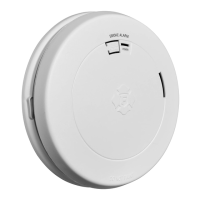
